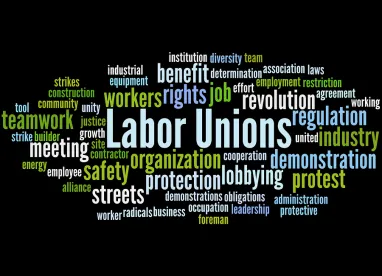On the eve of Independence Day, the NLRB, in a 3-1 decision (Member McFerran dissented), clarified the law concerning withdrawal and enunciated a new framework for determining whether a union has retained majority support at the conclusion of a contract term.
In Johnson Controls, Inc., 368 NLRB No. 20 (2019), the Board significantly streamlined the process for employees seeking to claim their own independence from their collective bargaining representative at the conclusion of the contract’s term. Now, if a majority of employees demonstrate that they do not want to be represented by a union within a reasonable time before contract expiration, and if the employer anticipatorily withdraws recognition, the union’s recourse to reestablish majority support is through a Board-conducted, secret-ballot election – not in adversarial unfair labor practice proceedings.
Employers no longer will be subject to unfair labor practice charges if they anticipatorily withdraw recognition and the union subsequently demonstrates majority support at the contract’s term. In sum, the employer’s anticipatory withdrawal will not be subject to an immediate competing claim of “majority” support for union representation within the several weeks of the end of the contract.
Prior Framework under Levitz
Under well-established precedent in Levitz v. Furniture Co. of the Pacific, 333 NLRB 717 (2001), if an employer receives evidence, within a reasonable period of time before its existing CBA expires, that the union representing its employees no longer enjoys majority support, it may withdraw recognition when the CBA expires and suspend bargaining over a successor contract – this is referred to as “anticipatory” withdrawal of recognition. Yet under that framework, the employer would be susceptible to a successful 8(a)(5) charge for refusal to bargain if – at the time the employer actually withdraws – there is evidence that the union re-acquired majority support. This framework has been criticized over the years because of the high degree of latitude the union is allowed to challenge the withdrawal in an unfair labor practice proceeding despite there being no evidence that the employer in any way interfered with the employee’s wishes.
The difficulty with such a framework, the Board in Johnson Controls explained, is that a union may defeat an employer’s withdrawal of recognition in an unfair labor practice proceeding with evidence that it reacquired majority status in the interim between anticipatory and actual withdrawal – regardless of whether the employer knew that the union regained majority support. Thus employers were left acting at their own “peril” under these circumstances; if subsequent union support was shown, then a remedy the Board would impose could be an affirmative bargaining order, which would preclude any challenges to the incumbent union’s majority support from as little as 6 months to as much as 3 years depending on if the parties reach a successor collective bargaining agreement.
The Levitz doctrine also created a so-called “last in time” rule, meaning that employees’ last preferences of union support (or lack thereof) were deemed determinative by the Board in an unfair labor practice proceeding. This created an incentive for both unions and employers to fail to disclose the identities of signers on their respective sides for fear of retaliation.
The Johnson Controls Board concluded that the Levitz framework failed to properly safeguard employee free choice by requiring employees to testify at unfair labor practice proceedings, and it also did not promote labor relations stability as employers would make unilateral changes that would have to be reversed.
A New Framework
In Johnson Controls, the Board established a new framework for these situations:
- If, within a reasonable time before an existing CBA or contract expires, an employer receives evidence that the union has lost majority status, the employer may inform the union that it will withdraw recognition when the contract expires, and it may refuse to bargain or suspend bargaining for a successor contract.
- The union then has several options:
- It may file an unfair labor practice alleging the employer initiated the union-disaffection petition or unlawfully assisted it; that the petition fails to make the employees’ representational wishes sufficiently clear; that the petition is tainted by serious un-remedied unfair labor practices; or that the valid signatures fails to establish loss of majority support.
- Significantly, however, the Board will no longer consider in such cases, whether a union has reacquired majority status as of the time recognition was actually withdrawn. Notably, the Board did not change the existing law that the employer is not obligated to provide the union with a copy of its disaffection evidence at the time it withdraws recognition anticipatorily. The union may acquire such evidence from its stewards and other pro-union employees, and the employer will be required to provide such evidence to the Region in any investigation.
- The biggest change is that if a union wishes to reestablish majority status, it must file an election petition, which the Board will process without regard to whether the parties’ contract is still in force at the time the petition is filed. The election will determine whether a majority of unit employees wish the union to continue to represent them after the contract expires.
45-Day Window
The Board also refined what a “reasonable time” before contract expiration where an anticipatory withdrawal may be effected is – now, it is no more than 90 days before the contract expires. In addition, a union must file an election petition within 45 days after the employer announces its anticipatory withdrawal – even if the employer gives notice within 45 days of contract expiration. Consistent with existing precedent, a rival union may also file its own petition during the 30-day “open period” prior to contract expiration (i.e., 60- to 90-days before contract expiration). Rival unions may also intervene if the incumbent union files an election petition.
The Board also stated that, to promote labor stability, employers are not required to withdraw recognition at contract expiration if the 45-day window for an election petition remains open or an election petition has been timely filed and an election remains pending.
Finally, when the incumbent union has filed an election petition within the 45-day window, employers who wish to continue recognizing that union are provided a “safe harbor” to continue doing so without unlawfully supporting a minority union under 8(a)(2). The “safe harbor” does not apply, however, when a rival union has filed an election petition or has intervened in the upcoming representation case. In that case, the employer must withdraw recognition.
Dissent Would Eliminate Withdrawal as Option
Member McFerran dissented, and focused on the fact that an incumbent union is entitled to a continuing presumption of majority support that must be measured solely at the time the employer withdraws recognition – regardless of the status of such support at the time the employer anticipatorily withdrew recognition. Member McFerran believed that the Levitz framework appropriately accounted for this important presumption.
Member McFerran also advocated for a rule that withdrawals of recognition should be unlawful absent an election; this position which was unanimously rejected by the Board in Levitz, most recently found support from then General Counsel Richard Griffin in 2016. The Johnson Controls majority flatly rejected this concept again, noting that it would be anomalous to hold that an election is the only means for a union to lose majority support, where a union’s status under Section 9(a) may be gained through voluntary recognition.
Takeaways – Impact of New Standard on Unilateral Changes Post-Withdrawal
The new standard provides helpful guidance to employers when faced with a decertification petition, or other evidence of employee support to be rid of the union representative, near contract expiration. It avoids the pitfalls attendant to the Levitz framework, when employers were required to take a leap of faith that the question as to the union’s continued majority support prior to contract expiration remained intact at the time of expiration despite clear evidence from the employees that they wished to be rid of the union. Losing that bet – after the time and expense of a lengthy challenge at the Board in response to unfair labor practice charges – would be costly for the additional reason that the employer could be subject to an affirmative bargaining order and likely would have unilaterally implemented certain changes that would have to be reverted.
Johnson Controls also has a significant impact on an employer’s ability to take unilateral action following a lawful withdrawal of recognition.
-
Employers may make unilateral changes in terms and conditions of employment during the intervening period between the date the contract terminates and the date of an election; however, if an election petition has been filed, an employer should be wary of making unilateral changes, as any such changes during the pre-election “critical period” could risk tainting the election and would result in a second election if the union loses.
-
If the union loses the election and does not file election objections and/or challenge a potentially determinative number of ballots, then the employer may act unilaterally.
-
But if the union loses and files election objections and/or challenges a potentially determinative number of ballots, an employer is risking an 8(a)(5) charge if it acts unilaterally.
-
The same risks to acting unilaterally are associated with cases where the employer challenges a union election win. As above, if the employer acts unilaterally but the outcome of the challenges to the election is a union win or a second election is directed, then the employer’s unilateral changes could furnish grounds for the union to file subsequent objections if it loses.
Blocking Policy Next to be Addressed?
This is a fairly narrow ruling, covering only the situation where the employer is confronted with loss of union status prior to the expiration of the parties’ agreement. The Board majority stressed it was not addressing the Board’s much criticized blocking policy, which allows a labor union to block a decertification petition, sometimes indefinitely, with little or no evidence of wrongdoing. Obviously, the blocking policy is on the Board’s radar screen and likely will be addressed in the near future.




 />i
/>i

